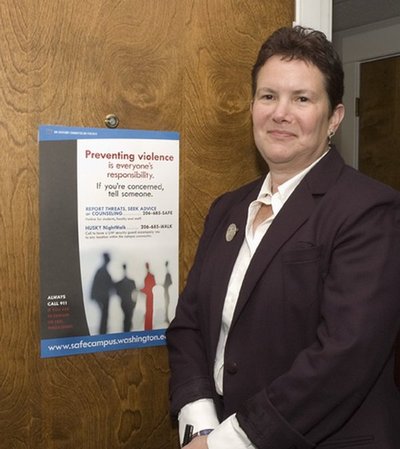September 27, 2007
UW SafeCampus: New Violence Prevention & Response Program up and running
Even as Janet Brodsky took a few minutes Friday to discuss her new job as the UW’s Violence Prevention & Response Program Manager, which oversees the new SafeCampus phone lines, news of another school shooting was spreading across the country — this time at Delaware State University.
“My initial reaction is that I feel so sad for our college communities that are suffering so much at the hands of violence, and I will do everything I can to reduce the risk here at the UW,” Brodsky said of the incident early Friday morning in which two students were injured.
The news also was the latest dark reminder that higher education environments are not immune from the threat of violence, and that though it’s often repeated it’s no less true that preventing violence is everybody’s responsibility.
That’s why Brodsky is here — to educate the campus community about dealing with violence and to be the point person for workplace violence issues campuswide. Also new as of June are SafeCampus phone lines for reporting any concern about potential or emerging threats of violence and a new Web page gathering together information and resources from campus and beyond.
The SafeCampus phone lines are:
- For the Seattle campus, 206-685 SAFE (7233)
- For UW Bothell: 425-352-SAFE (7233), and
- For UW Tacoma, 253-692 SAFE (7233.)
- And the Web page is: www.safecampus.washington.edu
Brodsky’s professional history shows she’s well prepared for her new job. “I’ve spent many years as a clinician, consultant and trainer in issues of the impact of violence on individuals and society,” she said.
She began working with trauma victims and their families in counseling centers and homeless and domestic violence shelters back as early as 1978, she said, and earned a master’s degree in social work from the UW in 1986. She later served 12 years at the Center for Sexual Assault and Traumatic Stress at Harborview Medical Center. More recently, she has spent the last 4 ½ years in private practice with Seattle Trauma Associates, helping children, teens and adults who experience severe traumatic stress.
But Brodsky has another campus role, too — she is now beginning her third year as faculty coordinator and lead instructor for the UW Extension’s certificate program in Psychological Trama: Effective Treatment and Practice.
Brodsky is joined in the Violence Prevention and Response Program by Nadine Gagnon, violence prevention and response specialist, and Carlene Cross, interim program manager. And given Brodsky’s skills in helping people overcome traumatic events, she said, “It seems like everything I’ve done up ‘til now has led to this position.”
Her days have been extremely busy since her arrival on campus a couple of weeks back. And so have the phone lines; “There hasn’t been a day I’ve been here when there haven’t been calls, although not all to report threats. Some are requests for SafeCampus posters or Workplace Violence Prevention presentations,” she said.
She talked a bit about what happens when a student, staff or faculty member calls the SafeCampus lines. “(Callers) will get a quick response,” she said straight off, “and they will be taken seriously.” Her office will review all calls, and assess whether further action needs to be taken.
She said people also may call the line even if they are concerned about their own behavior — “if they feel unable to calm themselves when angry or find they are obsessing about a relationship that has ended.” There are resources available to help people who are worried about their own conduct, and SafeCampus can help someone find the appropriate resource.
Brodsky also stressed that anyone under an immediate threat should call 911. “Then once you are safe, call the (SafeCampus) line,” she said. “We can make sure everyone knows who needs to know.”
She said, “My message is that if someone feels threatened or unsafe, they can call before something happens, and get help — and that way we can, hopefully, prevent violence.”
There were mechanisms for dealing with workplace violence before Brodsky’s arrival, to be sure, but she provides a new and visible point of contact for the whole campus community.
She described her prevention work as twofold, including both education — giving presentations about available resources and being a presence at campus fairs — and intervention in actual workplace situations, via the Workplace Violence Assessment Team. This team comprises representatives of UW Police, CareLink, Human Resources, the Attorney General’s Office and SafeCampus.
Brodsky said she became interested in this new challenge because “I had been helping people after the wreckage” of a traumatic event, “and I wanted to do more to prevent the wreckage.”
She described the UW’s approach to responding to and preventing workplace violence as “very intelligent and thoughtful — at the highest levels there’s been a lot of care being applied to how to put these mechanisms in place.
“This is a coordinated effort among all parts of the campus community — smoothing the working system that responds to threats.”



